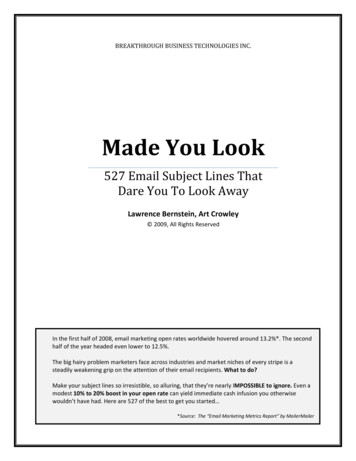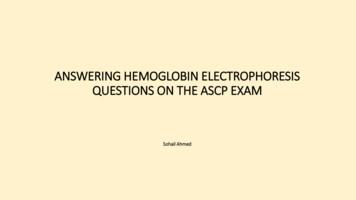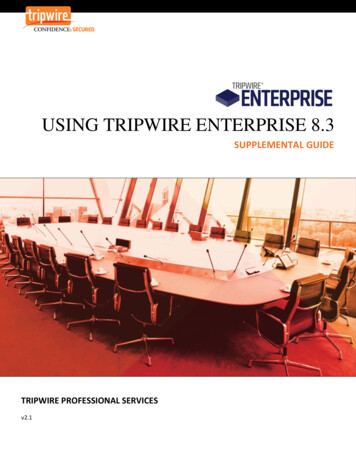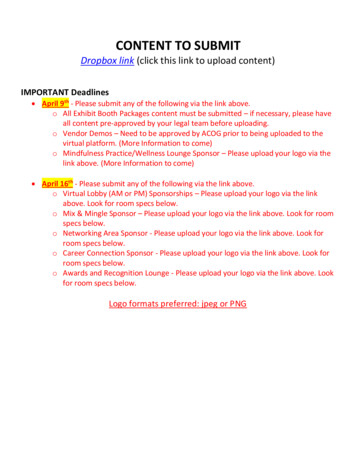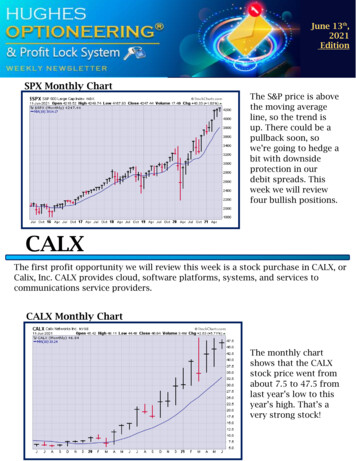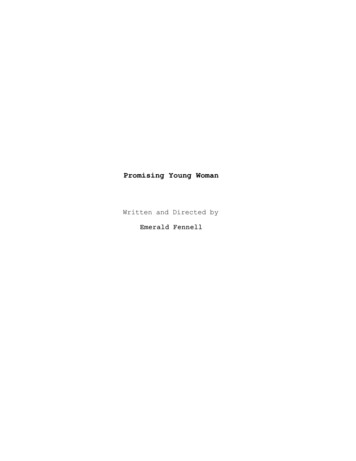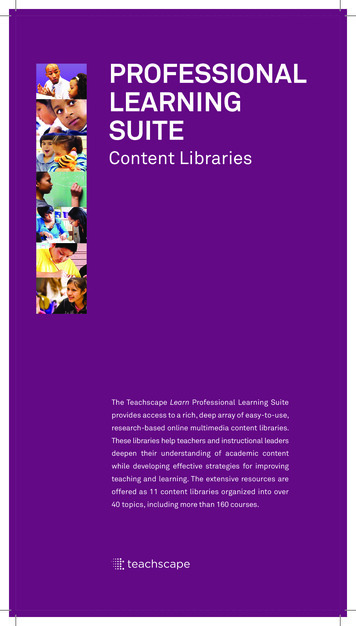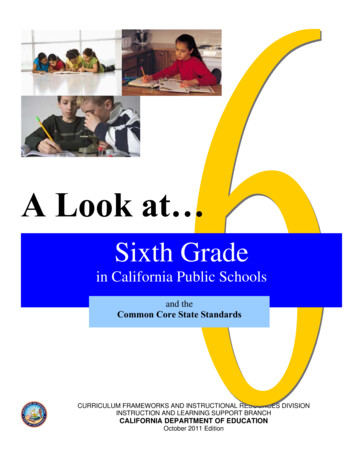
Transcription
A Look at Sixth Gradein California Public Schoolsand theCommon Core State StandardsCURRICULUM FRAMEWORKS AND INSTRUCTIONAL RESOURCES DIVISIONINSTRUCTION AND LEARNING SUPPORT BRANCHCALIFORNIA DEPARTMENT OF EDUCATIONOctober 2011 Edition
ContentsPageSixth-Grade Curriculum. 6.1English Language Arts . 6.2Overview . 6.2What Sixth-Grade Students Should Know . 6.2What Students Learn in Sixth Grade . 6.3Reading . 6.3Writing . 6.4Speaking and Listening . 6.5Language . 6.6Standards for Literacy in History/Social Studies, Science, and Technical Subjects . 6.6Extra Support for Struggling Readers . 6.7Support for English Learners . 6.8The Standards. 6.15Mathematics .6.25Overview . 6.25What Sixth-Grade Students Should Know . 6.25What Students Learn in Sixth Grade . 6.26Ratios and Proportional Relationships . 6.26The Number System . 6.27Expressions and Equations . 6.27Geometry. 6.28Statistics and Probability. 6.28Support for English Learners . 6.28Use of Calculators . 6.29The Standards. 6.30CCSS Domains . 6.36History–Social Science . 6.37Overview . 6.37What Sixth-Grade Students Should Know . 6.37i
What Students Learn in Sixth Grade . 6.38Early Humankind and the Development of Human Societies . 6.38The Early Civilization of Mesopotamia, Egypt, and Kush . 6.39The Ancient Israelites (Hebrews) . 6.40Ancient Greece. 6.41The Early Civilizations of India. 6.42The Early Civilizations of China . 6.44The Development of Rome. 6.45The Education and the Environment Initiative . 6.46Support for English Learners . 6.47The Standards. 6.48Science . 6.53Overview . 6.53What Sixth-Grade Students Should Know . 6.53What Students Learn in Sixth Grade . 6.54Plate Tectonics and Earth’s Structure . 6.54Shaping Earth’s Surface . 6.54Heat (Thermal Energy) (Physical Sciences) . 6.55Energy in the Earth System. 6.55Ecology (Life Sciences) . 6.55Resources . 6.55Investigation and Experimentation . 6.55The Education and the Environment Initiative . 6.56Science Across the Content Areas . 6.57Support for English Learners . 6.57The Standards. 6.58Visual and Performing Arts . 6.61Overview . 6.61What Sixth-Grade Students Should Know . 6.61What Students Learn in Sixth Grade . 6.62Dance . 6.62Music. 6.62Theatre . 6.62ii
Visual Arts . 6.62The Standards. 6.62Key Content Standards . 6.63Health . 6.69Overview . 6.69What Sixth-Grade Students Should Know . 6.69What Students Learn in Sixth Grade . 6.69Injury Prevention and Safety . 6.70Alcohol, Tobacco, and Other Drugs . 6.70Mental, Emotional, and Social Health . 6.70Support for English Learners . 6.71The Standards. 6.71Physical Education. 6.77Overview . 6.77What Sixth-Grade Students Should Know . 6.77What Students Learn in Sixth Grade . 6.78Overarching Standard 1: Students demonstrate the motor skills and movement patterns needed toperform a variety of physical activities. 6.78Overarching Standard 2: Students demonstrate knowledge of movement concepts, principles, andstrategies that apply to the learning and performance of physical activities. . 6.78Overarching Standard 3: Students assess and maintain a level of physical fitness to improve healthand performance. 6.79Overarching Standard 4: Students demonstrate knowledge of physical fitness concepts, principles,and strategies to improve health and performance. . 6.79Overarching Standard 5: Students demonstrate and utilize knowledge of psychological andsociological concepts, principles, and strategies that apply to the learning and performance of physicalactivity. 6.79Support for English Learners . 6.79Support for Students with Special Needs. 6.80The Standards. 6.81World Languages . 6.84Overview . 6.84What Sixth-Grade Students Should Know . 6.84iii
What Students Learn in Sixth Grade . 6.84Organization of the Standards. 6.85Content . 6.85Communication . 6.85Cultures . 6.85Structures . 6.86Settings. 6.86Stages of Proficiency . 6.86The Standards. 6.87School Library. 6.91Overview . 6.91What Sixth-Grade Students Should Know . 6.91What Students Learn in Sixth Grade . 6.92The Standards. 6.93iv
Sixth-Grade CurriculumWhat will my child learn in sixth grade?I’ve been teaching second grade, and this year I’ve been reassigned tosixth grade. What does the sixth grade curriculum look like?I’m the principal of a small private elementary school, and I want to besure my students are meeting the state’s standards. How can I find outwhat students are expected to learn at each grade?In August 2010, the state adopted the Common Core State Standardsfor English language arts and mathematics. How will the new standards enhance sixth-grade curriculum?This chapter is organized by sections for each subject, describing what students should know and be able todo by the end of sixth grade. Each section includes a brief overview of what the student should have learnedbefore entering sixth grade, followed by a description of the sixth-grade standards. Each subject concludes witha list of the sixth-grade standards for that content area. The English language arts and mathematics sectionsinclude the new Common Core State Standards (CCSS), with California additions.For a more in-depth discussion of each subject, please consult the state-adopted curriculum frameworks forkindergarten through grade twelve. The frameworks are posted on the CDE Curriculum and Instruction Webpage at ber 2011 Edition
English Language ArtsOverviewStudents in sixth grade focus on active engagement with text. They are required to analyze, identify, define,explain, integrate, evaluate, compare, contrast, and cite supportive evidence—developing and building uponthose skills that were required in fifth grade. Deeper analysis of literature and informational text continues to bethe focus of sixth-grade instruction, although reading fluently and accurately remains a Standards-basedgoal for all students. Students’ understanding of the precise meaning of words, English instruction is criticallanguage conventions, structural features of informational text and materials, andto developingfundamental elements of literature all support greater comprehension of what they read, students’ literacy andsee, and hear.proficiency in EnglishStandards-based instruction is critical to developing students’ literacy andlanguage arts.proficiency in English language arts. The standards describe what students are expectedto know and be able to do by the end of the school year. In 2010, California adoptednew standards in English language arts: the Common Core State Standards (CCSS),with California additions. The CCSS integrate the strands of English language arts: Reading, Writing, Speakingand Listening, and Language. The new standards will be implemented gradually over the next several years ascurriculum frameworks, instructional materials, and assessments based on the CCSS are adopted.There are many similarities between the CCSS and the 1997 California English language arts standards, butthere are also some notable differences. For instance, in the CCSS, the standards in sixth grade are divided intostrands: Reading, Writing, Speaking and Listening, and Language. In the 1997 California English language artsstandards, the standards are organized around domains: Reading, Writing, Written and Oral English LanguageConventions, and Listening and Speaking. An organizational change in the CCSS for grades six through twelveis the inclusion of another set of standards: Reading and Writing Standards for Literacy in History/SocialStudies, Science, and Technical Subjects. These standards are not intended to replace existing standards in thosecontent areas; instead, they supplement instruction and provide consistency in expectations across thecurriculum.This section provides an overview of the new CCSS for sixth-grade English language arts. It includes areview of the important English language arts skills and concepts from fifth grade (prerequisite skills) andguidance to ensure success for English learners. A complete list of the sixth-grade CCSS for English languagearts, with California additions, can be found at the end of this section. A complete listing of sixth-grade 1997California English language arts standards is located on the CDE Content Standards Web page entstnds.pdf.What Sixth-Grade Students Should KnowIn grade five, students read and analyzed a variety of historical and culturally significant works of literatureand focused more attention on comprehension of complex and narrative texts. Students read grade-level textfluently and accurately and mastered foundational reading skills in preparation for grades six and beyond.(Grade five is the last grade in which the CCSS include specific standards in foundational reading skills.)Students analyzed how structure, point of view, visual elements, and figurative language contribute to themeaning or tone of text. They expanded their comprehension and analysis skills to compare, contrast, andintegrate information from two or more texts; determined the theme or thesis; and used details and supportingevidence from the text to draw conclusions.6.2October 2011 Edition
Students learned academic language and domain-specific vocabulary through their reading and used it intheir writing and speaking. In writing, students learned to group related information logically; used words,phrases, and clauses to link opinions to reasons and related ideas; and incorporated narrative techniques todevelop a story line or characters. They wrote in both extended and short time frames for a range of contentspecific tasks, purposes, and audience. Technology played a larger role in students’ production and publishingof writing. Students also used technology to gather information for research projects and interact or collaboratewith others.In fifth grade, students engaged effectively in collaborative discussions, identified and analyzed logicalfallacies in speakers’ presentations or from media sources, and learned to plan and deliver presentations. Theyincorporated the conventions of standard English grammar and usage, capitalization, punctuation, and spellingto support their speaking and writing.What Students Learn in Sixth GradeStudents read and analyze a wide range of literature from different times andcultures, with an increasing emphasis on analyzing informational text on gradelevel topics in all sixth-grade subject areas. The emphasis in sixth grade is onstudents’ comprehension of complex narrative and informational texts. Studentsread two or more texts on a topic and use a variety of comprehension strategies tocompare, contrast, and integrate information from the texts. They analyze howstructure, point of view, visual elements, and figurative language contribute to themeaning or tone of texts. As their analysis skills deepen, students can identify keyindividual events and details and use them as evidence to support their analysis andto distinguish claims that are supported by an author from those that are not. Additional analysis skills call forstudents to compare and contrast one author’s presentation of events with another interpretation. They learnacademic language and domain-specific vocabulary through their reading and use it in their writing andspeaking.In their writing, students in sixth grade develop more sophisticated skills, such as using evidence from avariety of sources to support their purpose or conclusion. They revise, edit, and rewrite their compositions andlearn to try new approaches and use technology to improve their writing product. Students conduct researchprojects that provide them with practice in gathering information, using print and digital sources, andparaphrasing or summarizing information. Integrating reading and writing across the different content areas isemphasized through the addition of the standards for literacy in history/social studies, science, and technicalsubjects.Students engage effectively in collaborative discussions with diverse partners and in different groupings onsixth-grade topics and texts. They can identify and analyze logical fallacies in speakers’ presentations or frommedia sources. They learn to present an argument and support it with a logical sequence of evidence. They alsolearn to use expression and nonverbal elements for effect and to engage the audience. To support their writingand speaking, they learn conventions of standard English grammar and usage, capitalization, spelling, andpunctuation, such as using commas to set off parenthetical clauses. In sixth grade, the proper use of pronouns isemphasized. Developing academic as well as domain-specific vocabulary is highlighted. Students learn todistinguish between words with similar meanings and to use common affixes and roots as clues to the meaningof words. They also use the relationships between certain words (e.g., cause/effect or part/whole) to helpunderstand each word.ReadingThe following section is organized according to two areas of the reading standards: reading standards forliterature and for informational text.6.3October 2011 Edition
Reading Standards for LiteratureStudents in sixth grade read and analyze a wide range of literature, selected from different periods andcultures, including stories, drama, and poetry. In both the 1997 California English language arts standards andthe CCSS, students analyze the structures and elements of literary works in order to comprehend the texts. TheCCSS extend comprehension by having students compare and contrast reading a piece of literature withlistening to or watching an audio, video, or live version of the text. In addition, students compare and contrasttexts in different forms or genres in relationship to different approaches to similar themes or topics. Both the1997 standards and the CCSS ask students to identify a central idea or theme, using supporting evidence anddetails. Adding to those skills, the CCSS call for students to analyze how a certain sentence, chapter, scene, orstanza contributes to the development of the theme, setting, or plot. Students must also provide a summary ofthe text without including their personal opinions.There are similar word-analysis standards in the 1997 California English language arts standards and theCCSS. For example, students understand figurative language and similar or related words as they are used intext. Although recognition of frequently used foreign words is unique to the 1997 standards, this practice maycontinue in the CCSS as students analyze the impact of a specific word on meaning and tone.Reading Standards for Informational TextBy sixth grade, over 50 percent of reading time and activities should focus on informational text. Asstudents face increased reading demands in all sixth-grade content areas, improved comprehension becomescritical to their academic success.By sixth grade,In both the 1997 California English language arts standards and the CCSS, studentsover 50 percent ofusetheir knowledge of text structure, organization, and purpose to comprehend essentialreading time andideas and integrate information from different formats and types of text. They identifyactivities shouldkey individual events and details as evidence to support analysis the text. Students learnfocus oninformational text. to evaluate whether an author’s conclusion is supported by evidence or not.The CCSS emphasize additional analysis skills that call for students to compare andcontrast one author’s presentation of events with another interpretation—such as a personal diary by and abiography of the same person. To aid in the comprehension of text, the 1997 California English language artsstandards call for students to connect main ideas based on their relationship to other sources and topics. TheCCSS extend this skill by asking students to integrate information presented in different media or formats, suchas in charts or graphs, as well as in words, to clarify their understanding of a topic. To support theircomprehension of texts on sixth-grade topics in all subject areas, students determine the meaning of words andphrases, including content-related vocabulary, or words with technical meanings.WritingStudents in sixth grade demonstrate sophisticated writing skills from their use of specific vocabulary andsyntax to a more cohesive organization of ideas that incorporate a range of content and a variety of sources.Their writing demonstrates a command of the conventions of the English language, familiarity withorganizational features, and a clear style of writing appropriate for an identified purpose and audience, andexperience with the stages of the writing process (e.g., prewriting, drafting, revising, editing). Students usetechnology to compose and publish documents and to find resources and gather information to support theirmain idea.Both the 1997 California English language arts standards and the CCSS call for students in sixth grade towrite multiparagraph texts with a central idea or theme, relevant supporting details, precise words and visualimagery, and a conclusion. The purposes of writing that students produce are similar under each set ofstandards. Students write responses to literature, persuasive compositions, resear
language arts. proficiency in English language arts. The standards describe what students are expected to know and be able to do by the end of the school year. In 2010, California adopted new standards in English language arts: the Commo

